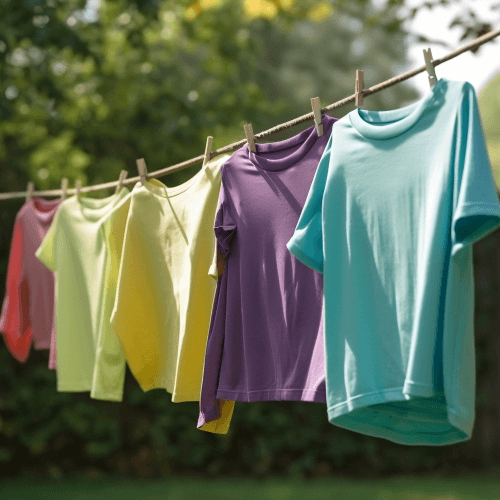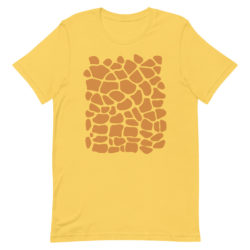T-shirts are an essential part of everyone’s wardrobe, and ensuring their colors stay bright and long-lasting is a priority. Appropriate care and maintenance are key factors in preserving the vivid shades of your beloved shirts. We’ll discuss crucial T-shirt cleaning practices to help you preserve shirt colors, focusing on four main areas: washing, drying, ironing, and storage.
How to clean and care for a T-Shirt
Table of Contents
Here is the quick summary of our shirt cleaning and caring guide. These shirt laundry tips will help your t-shirts stay colorful and vibrant.
- Washing methods:
- Choose between machine washing and handwashing shirts
- Machine washing is convenient, while hand washing is gentler
- Follow best practices for each method to maintain T-shirt vibrancy
- Drying methods:
- Decide between dryer and air drying
- Dryer offers speed, air drying is gentle and better for color retention
- Apply optimal techniques for each method to keep T-shirts fresh and colorful
- Ironing:
- Provides a polished, wrinkle-free look
- Follow top techniques to avoid damage and fading
- Check labels, turn T-shirt inside out, and use a pressing cloth
- Storage:
- Crucial for T-shirt durability, color preservation, and quality
- Use appropriate extended and temporary storage methods
- Fold, utilize breathable containers, select correct hangers, and maintain an organized wardrobe

How to Wash T-Shirts
Preserving the vivid colors of your T-shirts requires choosing the best washing technique. Both machine washing and hand washing have their unique advantages, and understanding their distinctions, as well as the ideal practices for each method, is essential. Let’s briefly discuss various T-shirt care elements, including washing frequency, washing alongside similar colors, washing inside out, selecting the appropriate detergent, machine washing, hand washing, and stain treatment.

Machine Washing vs. Hand Washing
Machine washing and hand washing each offer benefits in terms of cleaning your T-shirts. The decision between these methods largely depends on the garment’s fabric type, specific characteristics, and your personal preferences.
Machine washing is an efficient and convenient method, making it the preferred choice for many. However, the mechanical action in a washing machine can be abrasive on delicate fabrics, leading to color fading and fabric deterioration.
Hand washing offers a more delicate approach, making it perfect for garments made of fragile fabrics or those with intricate designs or decorations. This method aids in maintaining color
Ideal Practices for Machine Washing a T-Shirt
- Wash less frequently: Excessive washing can result in color fading. Wash your T-shirts only when required, and consider spot-cleaning minor stains.
- Wash alongside similar colors: Doing so helps to prevent color bleeding and transfer.
- Wash inside out: This step protects the print or graphic design from friction with other clothes.
- T-shirt detergent selection: Opt for a gentle T-shirt washing, color-protective detergent that is designed for colored fabrics.
- Select a gentle T-shirt wash cycle: Use the gentle cycle on your washing machine to minimize fabric wear.
- Use cold water: Cold water T-shirt wash reduces the possibility of color fading and dye bleeding.
Ideal Practices for Hand Washing a T-Shirt
- Fill a basin with cold water: Cold water is excellent for preserving colors and avoiding dye bleeding.
- Add a gentle detergent: Use a color-friendly detergent specifically intended for hand washing.
- Soak and softly agitate: Allow the T-shirt to soak for several minutes and gently agitate it to eliminate dirt and stains.
- Rinse completely: Rinse the T-shirt under cold running water until the water is clear.
- Gently press: Squeeze the T-shirt between your hands or against the basin’s side to remove excess water. Refrain from wringing, as it may damage the fabric.
T-shirt Stain Removal
Prior to washing, gently dab stains with a stain remover or a blend of water and gentle detergent as a pre-treatment. Avoid scrubbing the stain, as this may cause it to spread or sink deeper into the fabric. For optimal results, address stains as soon as they occur and follow the manufacturer’s guidelines for the stain remover.

Dryer Use vs Air Drying: Best Approaches for T-Shirts
When it comes to caring for your T-shirts after washing, choosing the appropriate drying method is crucial for maintaining vibrant colors and overall quality. Let’s explore the advantages of using a dryer compared to air drying and examine the optimal techniques for each method to ensure your T-shirts continue looking their best.
Utilizing a dryer and air drying each have their unique benefits in T-shirt care:
Dryer: The dryer provides a speedy and convenient drying solution for shirts, making it a popular choice for those seeking to save time. Contemporary dryers typically feature various settings, allowing for temperature and duration control to cater to different fabric requirements. Nevertheless, dryer heat can contribute to color fading, fabric shrinkage, and hastened wear on your T-shirts over time.
Air Drying: Air drying is a gentler method that exposes your T-shirts to less heat and mechanical stress, helping to preserve their colors and extend their lifespan. This eco-friendly option also conserves energy, reducing your utility expenses. However, air drying is a slower process compared to using a dryer, and clothes may feel stiffer than those dried in a machine.
T-Shirt Drying Tips for Drying T-Shirts in a Dryer
- Select low heat settings: Opting for the lowest heat setting minimizes potential fabric and color damage due to high temperatures.
- Dry T-shirts inside out: Drying your T-shirts inside out protects the print or graphic design from friction and wear.
- Dry alongside similar fabrics: Grouping T-shirts with other lightweight items, such as linens or delicates, can help prevent over-drying and fabric damage.
- Incorporate dryer balls or a clean tennis ball: These can help reduce static and promote even drying, beneficial for T-shirt fabrics.
- Remove promptly: Retrieve your T-shirts from the dryer as soon as the cycle concludes to help prevent wrinkles, making ironing simpler or, in some cases, unnecessary.

T-Shirt Drying Tips for Air Drying T-Shirts
- Gently press out excess water: Press the T-shirt between your hands or against the basin’s side to eliminate excess water before hanging. Refrain from wringing, as it can damage the fabric.
- Hang or lay flat to dry: For T-shirts prone to stretching, laying them flat on a drying rack is ideal. Alternatively, you can hang them on a clothesline, ensuring even weight distribution.
- Dry indoors or in shade: Direct sunlight may lead to color fading. Air dry your T-shirts in a shaded, well-ventilated location or indoors.
- Shake out wrinkles: Gently shaking out your T-shirts prior to hanging or laying them to dry can help minimize wrinkles, making ironing simpler or unnecessary.
- Keep T-shirts inside out: Air drying your T-shirts inside out shields the design from sunlight and dust, preserving the colors and graphics.

Ironing T-Shirts: Preventing Damage and Fading Colors
Ironing plays a key role in maintaining the appearance of your T-shirts, as it removes wrinkles and offers a refined look. However, unsuitable ironing methods can lead to damage and color fading. Let’s discuss the top techniques for ironing T-shirts to keep them looking vibrant and pristine without causing harm.
- Inspect the label: Always look at the label on your T-shirt for ironing guidelines and suggested temperatures. Certain fabrics, such as synthetic materials or delicate blends, may need a lower heat setting or should not be ironed altogether.
- Turn inside out: Inverting your T-shirt before ironing protects the print or graphic design from heat-induced damage and color loss. This also prevents any residue or dirt on the iron from adhering to the visible side of your T-shirt.
- Select the appropriate temperature: Adjust the iron’s temperature based on the fabric type. While cotton T-shirts usually require a higher heat setting, synthetic or blended fabrics need a lower temperature to avoid damage.
- Perform a small-area test: Before ironing the entire T-shirt, try the iron on a small region, such as a hem or seam, to confirm it doesn’t cause harm or color fading.
- Use a pressing cloth: Position a clean, damp pressing cloth, like a thin cotton towel, between your T-shirt and the iron to form a protective barrier. This method prevents direct contact between the iron and fabric, minimizing the likelihood of damage and color fading.
- Iron when slightly damp: Ironing a slightly damp T-shirt aids in wrinkle removal and reduces the chances of scorching the fabric. If the T-shirt is already dry, use a spray bottle to gently mist water on it prior to ironing.
- Refrain from stretching: During ironing, softly press and lift the iron without applying excessive pressure or stretching the fabric. Overstretching while ironing can result in fabric shape loss.
- Immediately hang or fold: Once you’ve finished ironing, promptly hang or fold the T-shirt to maintain its smooth appearance and stop the formation of new wrinkles.

How to Store T-Shirts
Good T-shirt storage not only keeps your clothes orderly but also helps preserve their colors, form, and general quality. Let’s cover various storage methods for T-shirts, with a focus on both extended storage solutions and temporary options such as hanging.
Long-term Shirt Storage
- Clean prior to storing: Before placing T-shirts in extended storage, make sure they are clean and completely dry. This helps prevent any dirt, oils, or stains from setting in and causing damage over time.
- Fold T-shirts: To optimize storage space and avoid wrinkles, neatly fold your T-shirts. Employing a consistent folding method will facilitate organization and make it easier to find specific items.
- Opt for breathable storage containers: Select breathable storage containers, like fabric or canvas bins, to hinder moisture accumulation and promote proper air circulation. This practice assists in maintaining the freshness and quality of your T-shirts during extended storage.
- Keep away from direct sunlight: Store T-shirts in a cool, dim location, away from direct sunlight, to avert color fading and fabric damage.
- Utilize acid-free tissue paper: For delicate or valuable T-shirts, consider wrapping them in acid-free tissue paper to safeguard the fabric from potential harm during storage.
Regular Use Shirt Storage
- Choose suitable hangers: Pick hangers that are appropriately shaped and sized for your T-shirts. Refrain from using wire hangers, as they can lead to misshapen shoulders or leave marks on your T-shirts. Instead, opt for plastic or wooden hangers featuring a contoured design that offers better support for your clothes.
- Hang T-shirts inside out: Hanging your T-shirts inside out can protect the print or graphic design from dust and light exposure, helping preserve the colors and design.
- Distribute hangers evenly: Allocate enough space between your hangers to encourage proper air circulation and prevent T-shirts from rubbing against each other, reducing the likelihood of wrinkles and fabric damage.
- Maintain an organized wardrobe: Keeping an organized wardrobe makes it simpler to locate and access your T-shirts. Sort your T-shirts by color, style, or occasion to establish a functional and visually appealing storage system.











